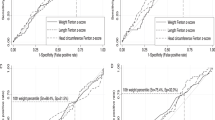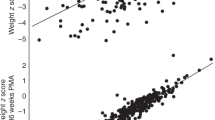Abstract
Objective
To report cognitive outcomes of preterm infants evaluated in a single center between 1980 and 2015.
Study design
Cognitive scores at a median age of 33 months were collected in preterm infants (birthweight ≤ 1000 g). Cognition was assessed using the Bayley Scales of Infant Development and the Stanford Binet Intelligence Scales.
Results
Six-hundred and two infants born between 1980 and 2015 were evaluated. Significant cognitive impairment for all infants decreased by 9.4% (p = 0.015) across the study period. For larger infants (birthweight ≥ 750 g), significant impairment decreased by 14.6% (p = 0.002). In smaller infants (birthweight < 750 g) no significant changes were observed in cognitive outcomes over the study period.
Conclusions
Overall, long-term outcomes of ELBW infants in our cohort showed significant improvement since 1980. Significant impairment decreased in infants with BW ≥ 750 g; and, despite increased survival of smaller (BW < 750 g) and sicker infants, significant impairment in that subgroup did not worsen over time.
This is a preview of subscription content, access via your institution
Access options
Subscribe to this journal
Receive 12 print issues and online access
$259.00 per year
only $21.58 per issue
Buy this article
- Purchase on Springer Link
- Instant access to full article PDF
Prices may be subject to local taxes which are calculated during checkout
Similar content being viewed by others
References
Fanaroff AA, Hack M, Walsh MC. The NICHD neonatal research network: changes in practice and outcomes during the first 15 years. Semin Perinatol. 2003;27:281–7.
Mercier CE, Dunn MS, Ferrelli KR, Howard DB, Soll RF. Neurodevelopmental outcome of extremely low birth weight infants from the vermont oxford network: 1998-2003 and the Vermont Oxford Network ELBW infant follow-up study group. Neonatology. 2010;97:329–38.
Wilson-Costello D, Friedman H, Minich N, Siner B, Taylor G, Schluchter M, et al. Improved neurodevelopmental outcomes for extremely low birth weight infants in 2000–2002. Pediatrics. 2007;119:37–45.
Moore T, Hennessy EM, Myles J, Johnson SJ, Draper ES, Costeloe KL, et al. Neurological and developmental outcome in extremely preterm children born in England in 1995 and 2006: the EPICure studies. BMJ. 2012;345:e7961.
Cheong JLY, Anderson PJ, Burnett AC, Roberts G, Davis N, Hickey L, et al. Changing neurodevelopment at 8 years in children born extremely preterm since the 1990s. Pediatrics. 2017;139:e20164086.
Adams-Chapman I, Heyne RJ, DeMauro SB, Duncan AF, Hintz SR, Pappas A, et al. Neurodevelopmental impairment among extremely preterm infants in the neonatal research network. Pediatrics. 2018;141:e20173091.
Marret S, Ancel P-Y, Marpeau L, Marchand L, Pierrat V, Larroque B, et al. Neonatal and 5-year outcomes after birth at 30–34 weeks of gestation. Obstet Gynecol. 2007;110:72–80.
Twilhaar ES, Wade RM, de Kieviet JF, van Goudoever JB, van Elburg RM, Oosterlaan J. Cognitive Outcomes of Children Born Extremely or Very Preterm Since the 1990s and Associated Risk Factors. JAMA Pediatr. 2018;172:361–7.
Bayley N. Bayley scales of infant and toddler development. 3rd ed. San Antonio, TX: Harcourt Assessment Inc.; 2006.
Bayley N. Bayley scales of infant development manual. San Antonio, TX: The Psychological Corporation; 1969.
Bayley N. Bayley scales of infant development. 2nd ed. San Antonio, TX: The Psychological Corporation; 1993.
Johnson S, Moore T, Marlow N. Using the Bayley-III to assess neurodevelopmental delay: which cut-off should be used? Pediatr Res. 2014;75:670–4.
Moore T, Johnson S, Haider S, Hennessy E, Marlow N. Relationship between test scores using the second and third editions of the bayley scales in extremely preterm children. J Pediatr. 2012;160:553–8.
Vohr BR, Stephens BE, Higgins RD, Bann CM, Hintz SR, Das A, et al. Are outcomes of extremely preterm infants improving? Impact of Bayley assessment on outcomes. J Pediatr. 2012;161:222–28.e3
Doyle LW, Anderson PJ. Do we need to correct age for prematurity when assessing children? J Pediatr. 2016;173:11–2.
Romeo DM. Correcting for prematurity with the Bayley Scales of Infant Development. Dev Med Child Neurol. 2018;60:736–7.
Wilson-Ching M, Pascoe L, Doyle LW, Anderson PJ. Effects of correcting for prematurity on cognitive test scores in childhood. J Paediatr Child Health. 2014;50:182–8.
Johnson S, Hennessy E, Smith R, Trikic R, Wolke D, Marlow N. Academic attainment and special educational needs in extremely preterm children at 11 years of age: The EPICure study. Arch Dis Child Fetal Neonatal Ed. 2009;94:F283-9.
Terman LM, Merrill MA. Stanford-Binet intelligence scale: manual for the third revision form L-M. Houghton M. Boston, MA; 1960.
Thorndike RL, Hagen EP, Sattler M. Stanford-Binet Intelligence Scale: Fourth Edition. Riverside Publishing. Chicago, IL; 1986.
Bell MJ, Ternberg JL, Feigin RD, Keating JP, Marshall R, Barton L, et al. Neonatal necrotizing enterocolitis. Therapeutic decisions based upon clinical staging. Ann Surg. 1978;187:1–7.
Papile LA, Burstein J, Burstein R, Koffler H. Incidence and evolution of subependymal and intraventricular hemorrhage: a study of infants with birth weights less than 1,500 gm. J Pediatr. 1978;92:529–34.
Stoll BJ, Hansen NI, Bell EF, Shankaran S, Laptook AR, Walsh MC, et al. Neonatal outcomes of extremely preterm infants from the NICHD neonatal research network. Pediatrics. 2010;126:443–56.
Acknowledgements
We thank Dr Eduardo Bancalari M.D. and Dr Nelson Claure Ph.D. for their help and support throughout this project. We also would like to thank Emmanuel Courchia for his help in the early stages of data analysis.
Author information
Authors and Affiliations
Corresponding author
Ethics declarations
Conflict of interest
The authors declare that they have no conflict of interest.
Additional information
Publisher’s note: Springer Nature remains neutral with regard to jurisdictional claims in published maps and institutional affiliations.
Rights and permissions
About this article
Cite this article
Courchia, B., Berkovits, M.D. & Bauer, C.R. Cognitive impairment among extremely low birthweight preterm infants from 1980 to present day. J Perinatol 39, 1098–1104 (2019). https://doi.org/10.1038/s41372-019-0414-x
Received:
Revised:
Accepted:
Published:
Issue Date:
DOI: https://doi.org/10.1038/s41372-019-0414-x
This article is cited by
-
Neurodevelopmental outcome of Italian preterm ELBW infants: an eleven years single center cohort
Italian Journal of Pediatrics (2022)



